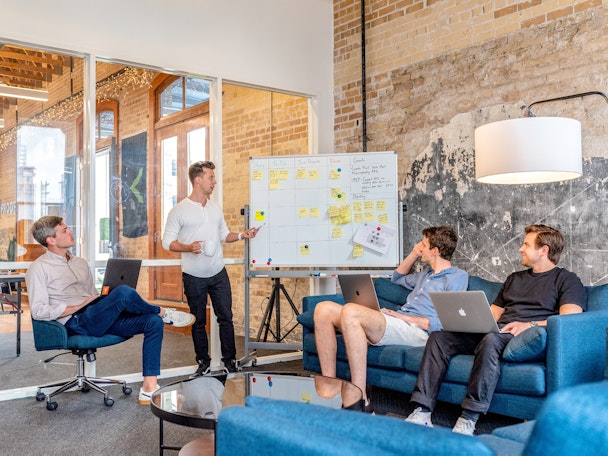The new approach to new business that helped TBWA\MCR get off the pitching merry-go-round
Agencies across the globe want to win new work through ‘land and expand,’ but chances don’t come along often. TBWA\MCR may have found a solution.

It’s actually quite hard to visualise the concept of not pitching, to be honest / Unsplash
Earlier this year, TBWA\MCR won the account for Legoland, expanding an existing relationship with the brand’s parent Merlin Entertainment (the firm behind Alton Towers, which also licenses the Legoland name from the Danish toymaker).
For most agencies, that’s pretty much the ideal new business scenario. “Pitching is such a drain on agency resources that anything you can to do navigate your way through it in a more agile way, rather than throwing the whole creative department at something for four weeks, is a benefit,” says Fergus McCallum, chief executive officer of TBWA\MCR.
Advertisement
In the Legoland case, the agency was invited to provide its perspective off the back of its previous work for Merlin. The team presented a “strategic approach” to the brand, which advised “putting the ‘land’ back in Legoland,” a nugget that ended up driving the agency’s work for the theme park later down the line. “It’s a much healthier way of building new business,” says McCallum.
The rub, however, is that clients don’t often invite agencies in to have these conversations. It’s a necessarily opportunistic approach to new business.
One particularly wasteful exercise pitching for a household brand name last year galvanized TBWA\MCR to search for an alternative route. “We had the opportunity to pitch for a very well-known consumer goods brand, a very creative business, and we got down to the shortlist,” recalls McCallum. “In the briefing, I sat in front of the CMO and asked why they were pitching. He said, ‘I’d prefer not to tell you.’ Then I asked how many they were going to shortlist, and he said, ‘Well, I’m not sure yet, probably six to eight.’”
Shortly afterward, the agency walked away from the pitch. “It’s a big brand, we’d love to work on it, but not on those terms.” In response, the team began working on a way of provoking clients into having similar discussions as the one that led to the Legoland win.
Advertisement
Lorna Hawtin, disruption director at the agency, tells The Drum that they reached out to consultants in other kinds of service sectors for some ideas. “One consultant in the IT sector shared an idea that had resulted in success, which got us sitting forward. It centered on the creation of a real value exchange between consultant and prospect, which became the starting point for this new approach,” she recalls.
The agency was able to combine a “hot-house” session with a workshop format it had been using with smaller clients, resulting in ‘Disruption Firestarter’ – essentially a trial strategy session at the agency’s city center offices run by two or three TBWA staffers and directed at a similar number of brand marketers. The in-person meeting is followed up by a “gold-mining” session that gives the team a chance to take the conversation further. Though there’s some time spent in preparation, it is “delivered in a more agile way” than usual, she says,
According to McCallum: “It gives clients an opportunity to test drive us. If they make a commitment to get senior people in the room and to talk about the issues they have as an organization from a marketing or creative perspective, we’ll run a workshop and help them explore what it is they need to do.”
Suggested newsletters for you
The concept has helped deepen furtive links to new clients and expand ones with brands already on the agency roster, which includes gym chain David Lloyd and gardening brand Westland.
“We find that’s a great way of building chemistry and they actually get value out of the meeting,” says McCallum. Crucially, it offers both the agency and the brand a way around the sometimes onerous pitching ritual.
Hawtin adds: “As a result, in the last few months we’ve brought in two major pieces of new business, as well as three or four new projects that would have been too small to pitch for but are nevertheless valuable to the agency. It means we’ve been successful in creating new creative and income opportunities without the costs and time associated with pitching. That’s a win for us and the clients in question.”
McCallum adds: “It gives them a sense of what we’re like to work with and I don’t think you get that from a pitch. Pitches are so false – you might get a tissue meeting but you don’t really talk to the client. What we’ve found is that these Disruption Firestarters allow you to sit around a table, talk about the issues and help them come to some solutions.
“Pitch processes use up a lot of resources for clients as well. The Disruption Firestarter approach means a lower cost for us and better value for them.”
TBWA\MCR is the only agency in the worldwide network to be using Disruption Firestarter so far, but McCallum says the Firestarter sessions have yielded more project work from clients – some existing and some new – something he’s been keen to embrace.
“The thing about project-driven business is it makes the client think more about the scope of work required,” he says. Retainer-led relationships can be “nebulous” by comparison, while thinking in terms of a series of projects enables both client and agency to think harder about the outputs of marketing work – and an honest appraisal of scope helps the agency staff-up and potentially save costs in the long-run, too.

